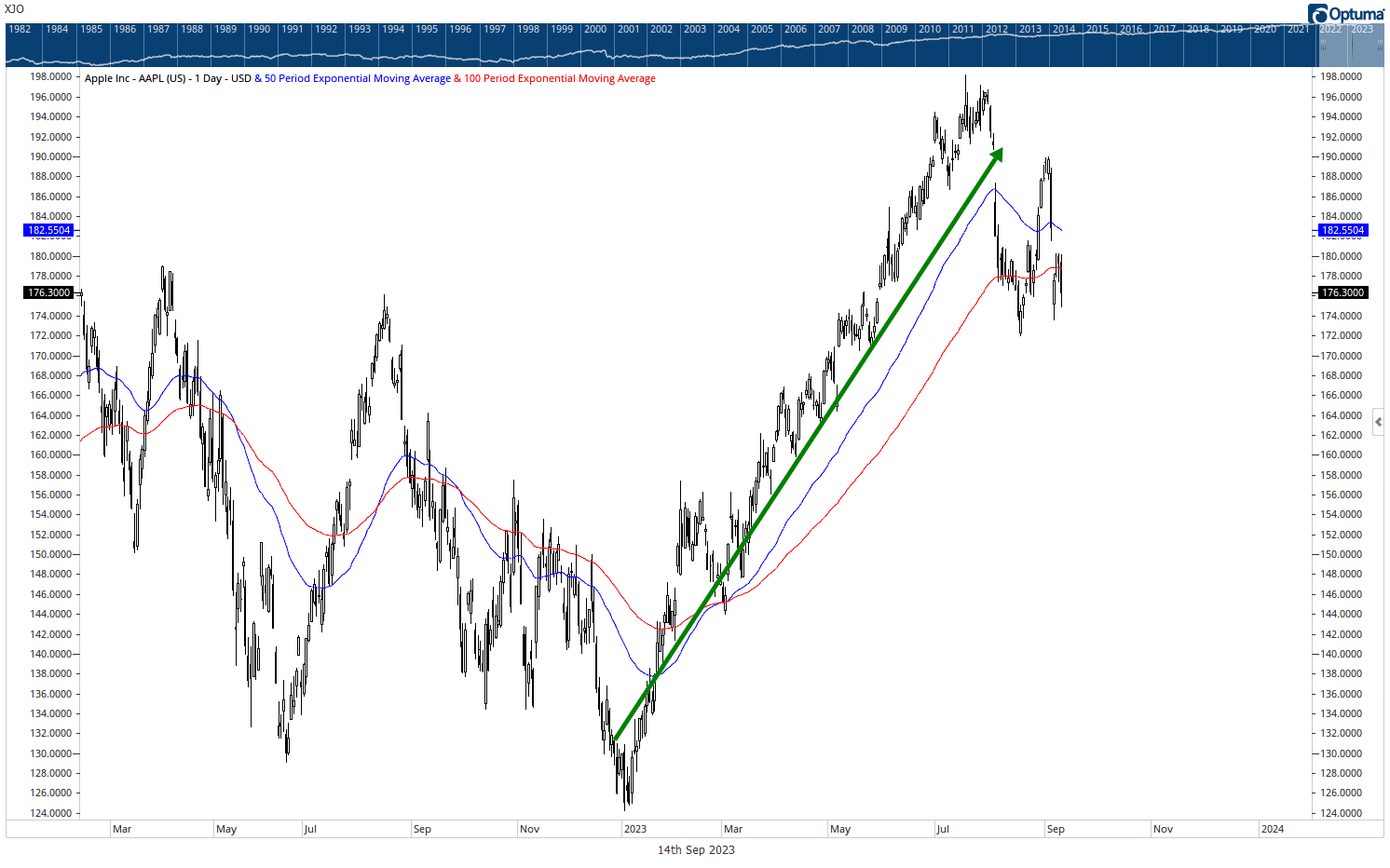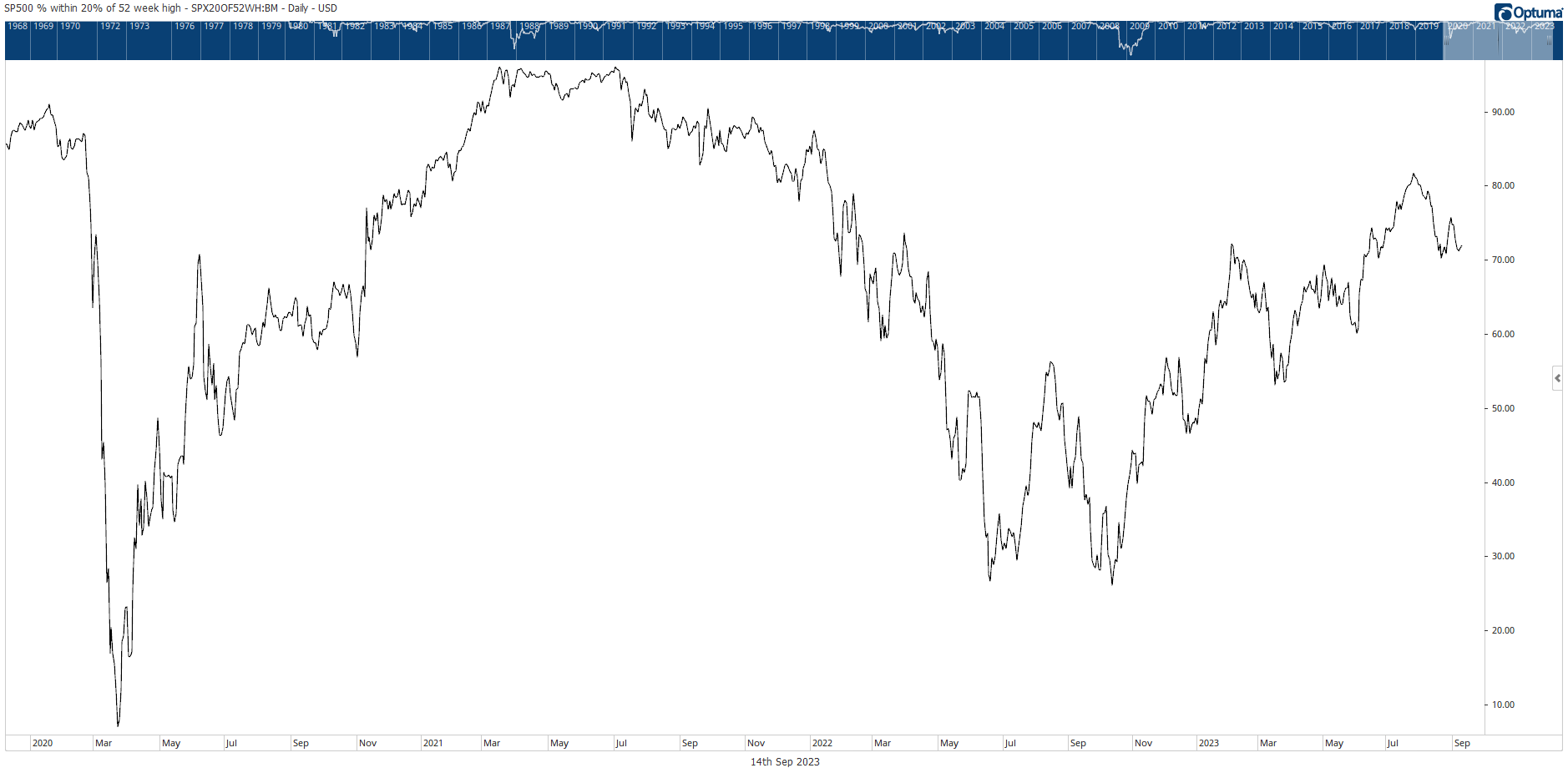This bear market rally peaked in July
In the last wire I wrote back on 11 August, I argued that the momentum trade was breaking down. At the time, the S&P500 was trading at 4,464 points. Last night it closed at 4,505.
So in the past month, the world’s benchmark index has edged higher. No breakdown, and no breakout.
Obviously, a month isn’t long enough to judge the validity of a longer-term call. But I wanted to update you on this idea because there are a few things going on beneath the surface that suggests the big rally in US markets since the October 2022 low (and less so in global markets, including Australia) is indeed faltering.
For starters, I pointed to Apple being the pin-up stock for the momentum trade. As you can see in the chart below, the sharp upward trend that was in place from January to the late July top is definitively broken.

The next level to watch for is the August low around US$170. A break below there should see decent selling and a considerably lower share price.
The other thing to note is that when Apple (and the momentum trade in general) topped out in late July, just over 80% of S&P500 stocks were within 20% of their 12-month highs (see chart below).
This tells you that only 20% of S&P500 stocks were in a bear market in late July. (The standard definition of a bear market being a 20% or greater correction from the high).
That’s not as high as the 95% reading when the bull market peaked out in late 2021. But then again, we’re not in a bull market. An 80% reading for a bear market rally is high. That’s exactly where S&P500 stocks got to in the bear market rally of 2002. So I wouldn’t be surprised if the current ‘80% of stocks in a bull market' reading suggests the market is peaking out here too.

Shifts from strong-to-waning momentum take time to play out. And that shift is usually accompanied by a shift in sentiment. And you’re seeing that change too.
The CNN Fear and Greed index was in the ‘extreme greed’ reading for much of June and July. It peaked at 84 on 18 July, one week before the market topped out.
Since then, the indicator has moved from extreme greed, to greed, and into a neutral reading. Other sentiment indicators have also come off their highs of a few months ago.
This in itself is no big deal. Extreme bullish or bearish sentiment indicators don’t hang around for long.
Don't believe the consensus narrative
But my argument is that we’re in a transition stage. And that means we could be heading into more bearish readings in the months ahead.
Why?
The consensus is that we’re in for a ‘soft landing’. Therefore, there’s nothing to worry about! This soft landing narrative has come about in the past few months because of the US economy’s resilience and ability to defy constant predictions of recession.
Why has it been able to do this though? Because the lingering effects of stimulative fiscal policy has offset the effect of monetary tightening. But the positive boost from fiscal policy is set to expire. That’s according to an article published at the San Francisco Fed on 16 August last year. Here’s the important bit:
‘In a study earlier this year (Abdelrahman and Oliveira 2023), we examined household saving patterns since the onset of the pandemic recession. Our study showed that households rapidly accumulated unprecedented levels of excess savings—defined as the difference between actual savings and the pre-recession trend—relative to previous recessions. Our analysis suggested that some $500 billion of the $2.1 trillion in total accumulated excess savings remained in the aggregate economy by March 2023.
‘Since then, data revisions show noticeable changes in household disposable income and consumption, while new data releases indicate that consumer spending picked up in the second quarter. Our updated estimates suggest that households held less than $190 billion of aggregate excess savings by June. There is considerable uncertainty in the outlook, but we estimate that these excess savings are likely to be depleted during the third quarter of 2023.’
That’s in roughly two weeks. In other words, monetary policy will very soon be acting without constraint, and the US economy is likely to slow sharply.It's the same with Aussie households, with savings rates at the lowest point since June 2008.
Meanwhile, the US market is swanning about with barely a risk to consider. According to consensus estimates, 2024 calendar year earnings are set to grow 12% over 2023. Based on the 12-month forward consensus estimates, the S&P500 trades on a price-to-earnings multiple of 18.75.
That represents an earnings yield of 5.33%. The 10-year US bond yield currently trades around 4.3%. In other words, based on reasonably rosy forward earnings estimates, the stock market doesn’t offer much additional reward over ‘risk-free’ bonds.
How is this resolved in favour of the stock market? Well, earnings would have to increase faster than already expected, or bond yields would have to fall significantly.
With the lagged impact of monetary tightening still working its way through the economy, and about to do so without the offsetting stimulus from fiscal policy, better than expected earnings growth is a low probability, especially as the bar is already set at a high level.
Falling bond yields are I think a much higher probability. However, it will be because of weak economic growth (and possibly recession in the US) which will obviously be bad for company earnings and therefore the stock market.
Economist Dave Rosenberg sees a recession on the cards in the next quarter or two. He firmly refutes the idea of a ‘soft landing’, something the stock market is currently pricing in. In his latest research note, he writes:
‘And for those who don’t see a recession, just remember the traditional lag from the Fed’s first volley to the time of the recession historically was not 22 minutes, 22 hours, 22 days, or 22 weeks. More like 22 months. That puts Q4 of this year or Q1 of next year in play. All “soft landings,” and they can easily last a year (think 1989, 2000, 2007), are bridges from the expansion to the contraction phase of the cycle. They are a transition period. And they are not permanent. Either the economy somehow reaccelerates (with looming fiscal tightening and the lagged impact from the Fed in terms of what still lies ahead makes that unlikely), or it downshifts into recession.’
So keep that in mind when allocating capital in the weeks ahead. It’s worth having some cash on hand to take advantage of any opportunities that might arise during this seasonally weak period.
***
Don’t forget, as a valued Livewire reader, we're offering you an opportunity to gain immediate access to my Fat Tail Investment Advisory with an incredible discount of up to 70% when you join today.
3 topics

